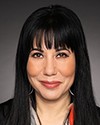Yes, I appreciate that, Damon, because I know that the families of murdered and missing indigenous women have been fighting very hard in our community to secure more low-barrier safe spaces. I appreciate your involvement in housing over the years trying to improve the situation in our community, so thank you for that.
My next question is for Dr. Christensen, with regard to intersectionalities. November was Indigenous Disability Awareness Month, and we know that indigenous people in Canada have a disability rate significantly higher than the general population and often deal with intersectional discrimination, both having a disability and being indigenous.
According to Statistics Canada, in 2017, 32% of first nations living off reserve, 30% of Métis and 19% of Inuit had one or more disabilities that limited them in their daily activities. How should this disproportionate number of indigenous persons with disabilities be considered when indigenous housing strategies are created and funded?
I say that because often the housing that is created may not necessarily be accessible or provide the support, under article 19 of the UN Convention on the Rights of Persons with Disabilities, to live in dignity. Could you speak to that specifically?

